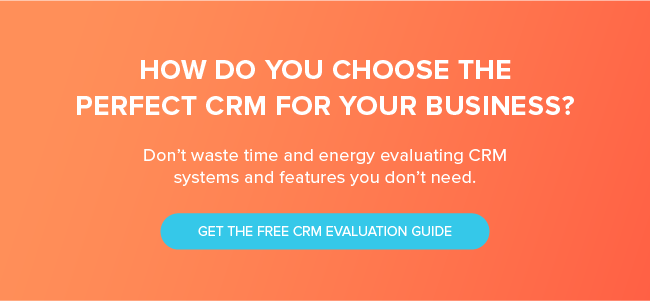Changing your tools or processes can be a major decision, especially when that change requires a financial investment.

If you’re reading this post, you’re probably wondering whether CRM software makes sense for your business. How will it affect your sales, marketing, or services workflows? How long will it take to see a return? As you weigh the evidence, look for these seven warning signs that may indicate you need one.
1) Low Efficiency/Productivity
Manual processes like spreadsheets and paper approvals waste a considerable amount of time. There are better ways to get things done. A CRM replaces manual processes by automating data entry and repetitive tasks, and by bringing account-related team communication into a single, shared interface (no more siloed email chains).
Not only does that lead to improved efficiency, but it also can improve sales success, to the tune of 41% higher revenue per salesperson.
2) Breakdown of Collaboration Between Departments
Sometimes departments become so engrossed in their day-to-day work that they start to lose track of what other departments are doing and how they impact one another. While clients or potential customers are interacting with your company, they may find themselves being bounced around and misinformed because no one's entirely sure how to handle their needs.
A CRM allows anyone in the organization to see the lifecycle of each customer or lead and know exactly how to address their needs. This visibility is often accomplished through CRM features such as team dashboards and file sharing.
3) Limited Accountability Among Associates
Sometimes, salespeople will shy away from taking responsibility for a client who “fell through the cracks” because it “wasn’t their job.” Or worse, you miss a customer opportunity because no one took charge and contacted them.
A CRM acts as a centralized database and provides precise data on every interaction you have with customers and leads. This tells you who, where, and when someone fell short on taking care of a client. The intention here isn’t to point fingers at anyone, but rather provide a clear picture on where there is room to improve.
4) Poor Data Analysis
You want to believe you know your clients and that you’re doing everything possible to serve them. But there may be a few things you don’t know about them. The less data you have access to, the less you know.
A CRM can help you understand your customers better through built-in reporting and data analysis. Using these tools, you can gain insight into shopping and seasonal habits, demographics, digital behaviors, and specific preferences, such as their preferred method of communication.
5) Low Customer Satisfaction
A customer experience that does less than delight someone is a wide-open door for your competition. If you’ve noticed low satisfaction rates, a higher volume of complaints, or poor responses to customer surveys, it may be time for a solution.
With a CRM, you can take a targeted approach to customer experience management. For example, the best CRMs let you engage those clients who prefer mobile and social channels over email or phone. In fact, you might save some resources in the process; one study found that mobile capabilities lead to an average productivity gain of 14.6%, and social capabilities to an 11.8% gain.
6) Missed Sales Opportunities
If you’re tracking your sales leads manually, you may be lacking a clear process for nurturing them and ultimately missing out on sales opportunities. A CRM (especially when connected to marketing automation software) can use automation rules to notify reps when it’s time for a follow-up. Not only that, but because of the stored information and communication records, you can seamlessly pick up where your nurture programs left off, adding value to the relationship you’ve already built.
7) Rapid Business Growth
Even small businesses can benefit from the advantages of a CRM, especially when they’re ready to grow. As is the case with many software tools, the question often becomes, “How do I know I’m selecting the right size platform?”
This is a legitimate concern, since it relates to the number of employees you have and the volume of clients you are managing. But thanks to software-as-a-service (SaaS) pricing models, most CRMs can grow as you grow. If you start with two employees and grow to 200, your CRM can scale along with you.
As you weigh the pros and cons of adopting CRM software, it’s important to consider the potential dangers of manual sales and marketing workflows. Working with a CRM puts you in a position to streamline interactions between departments, improve and customize your clients’ experience, and realize an increase in productivity and revenue.







![The 12 Best Client Management Software for Any-Sized Team [+My Insights]](https://www.hubspot.com/hubfs/screenshot-2024-08-26-at-42754-pm-66cce54da128a.webp)


